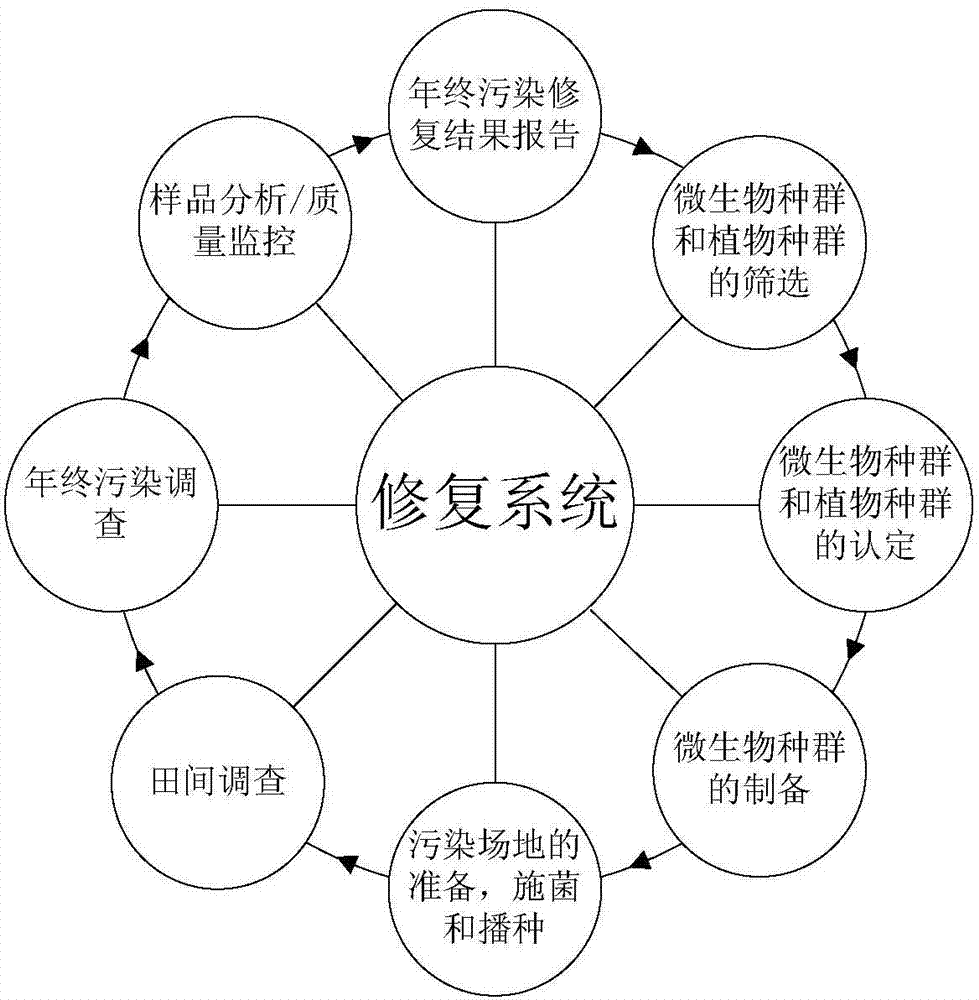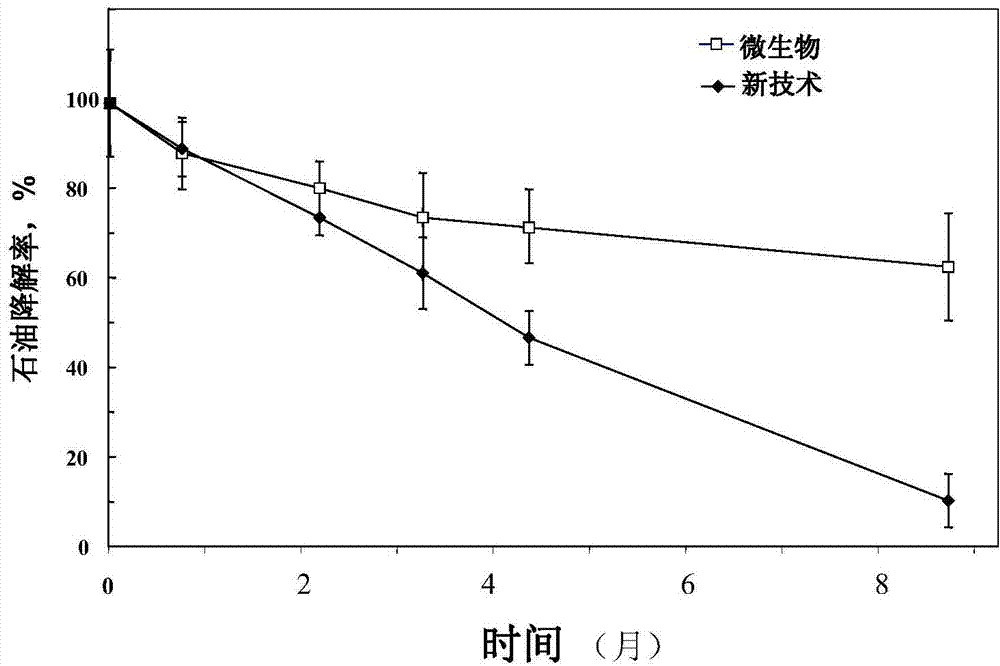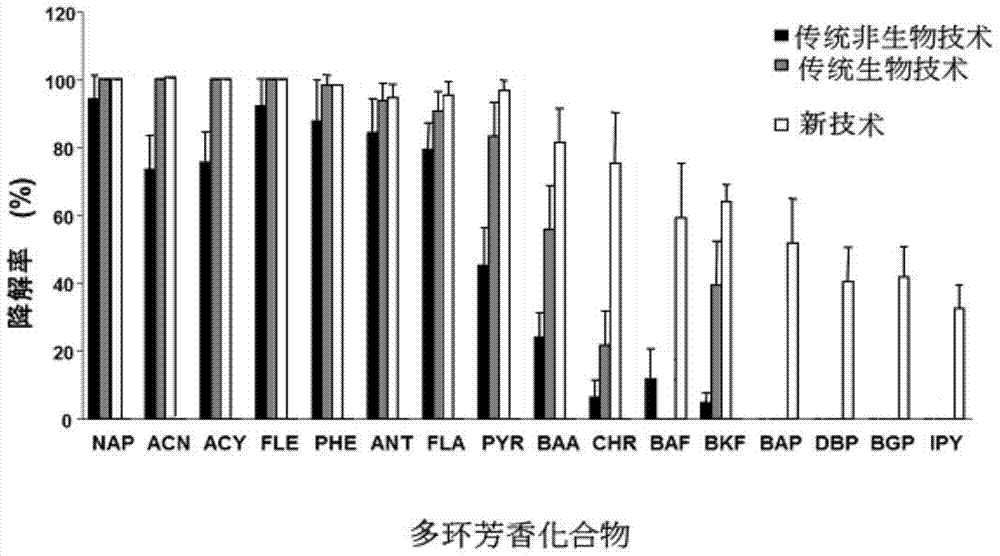Method for biologically repairing soil polluted by petroleum hydrocarbon compounds and application
A bioremediation and petroleum hydrocarbon technology, applied in the field of soil remediation, can solve the problems of difficult application of soil remediation technology, restricted degradation, slow mass transmission speed, etc., and achieve the effects of shortening soil remediation time, simple implementation and wide applicability
- Summary
- Abstract
- Description
- Claims
- Application Information
AI Technical Summary
Problems solved by technology
Method used
Image
Examples
Embodiment 1
[0072] The remediation process of oil-contaminated soil in the Central Plains (Henan Province), the process can be roughly found in figure 1 shown. The soil contains 5600ppm of heavy oil; the area is 1.5 hectares of typical local farmland; the crops (wheat and corn) are not growing; in February 2010, the land was prepared, leveled, fertilized (N: 10 kg / mu), and remediation biological agent (100 kg per mu) and rotary tillage; sowing in early March, mixing annual ryegrass (Lolium multiflorum), perennial ryegrass (Lolium perenne) and tall fescue grass (Festuca arundinacea) in a ratio of 2:1:1, the dosage per mu was 16 kg; Carry out bacterium liquid coating before sowing, coating bacterium is Pseudomonas cedrina UW3 and Pseudomonas putida UW4 fermentation bacterium stoste (patent 200810181327.8 embodiment 1 is prepared to the bacterium liquid that step (16) obtains), by 8ml / kg seed coating, 20,000 Bacterial cells / granule; during the repair process of 8 months, cut 2 times, at the...
Embodiment 2
[0074] The remediation process of coal tar-contaminated soil in Northeast China (Liaoning Province). The soil contains 3100ppm of coal tar pollution; the area is 2.1 hectares; crops (wheat and corn) cannot grow; in March 2011, the land was prepared, leveled, fertilized (N: 10 kg / mu), and remediation biological agents (100 kg / mu) were applied and rotary tillage; sowing in early April, mixing annual ryegrass (Lolium multiflorum), perennial ryegrass (Lolium perenne) and tall fescue grass (Festuca arundinacea) at a ratio of 2:1:1, with an amount of 20 kg per mu; Bacteria solution coating, the coating bacteria solution is Pseudomonas cedrina UW3 and Pseudomonas putida UW4, 20,000 bacterial cells / grain; during the repair process of 6 months, cut twice, at the end of June and August; sampling in early October (30 pieces) Analysis and testing, the results are summarized as follows: the degradation rate of the new technology is 82%, the traditional microbial technology is 43%, and the ...
Embodiment 3
[0093] Remediation Process of Heavy Oil Contaminated Soil in Northeast China (Heilongjiang Province). The soil contains 1200ppm of heavy oil pollution (mainly the part of 15-25C molecules); the area is 0.5 hectares in April 2009, land preparation, leveling, fertilization (N: 10 kg / mu), application of remediation biological agents (50 kg / mu) and Rotary tillage; sow on May 20, mix annual rye and tall fescue grass (Festuca arundinacea) at a ratio of 3:1, and use 20 kg per mu; seeds are coated with bacterial solution before sowing, and the coated bacterial solution is Pseudomonas cedrina UW3 and Pseudomonas putida UW4, 20,000 bacterial cells / grain; during the repair process of 5 months, harvested once, in mid-July; on October 20, the initial sampling (3) was analyzed and tested, and the results are summarized as follows: Degradation of new technology The rate is 55%, and the traditional microbial technology is 15%. The result is as Figure 4 shown.
PUM
 Login to View More
Login to View More Abstract
Description
Claims
Application Information
 Login to View More
Login to View More - R&D
- Intellectual Property
- Life Sciences
- Materials
- Tech Scout
- Unparalleled Data Quality
- Higher Quality Content
- 60% Fewer Hallucinations
Browse by: Latest US Patents, China's latest patents, Technical Efficacy Thesaurus, Application Domain, Technology Topic, Popular Technical Reports.
© 2025 PatSnap. All rights reserved.Legal|Privacy policy|Modern Slavery Act Transparency Statement|Sitemap|About US| Contact US: help@patsnap.com



